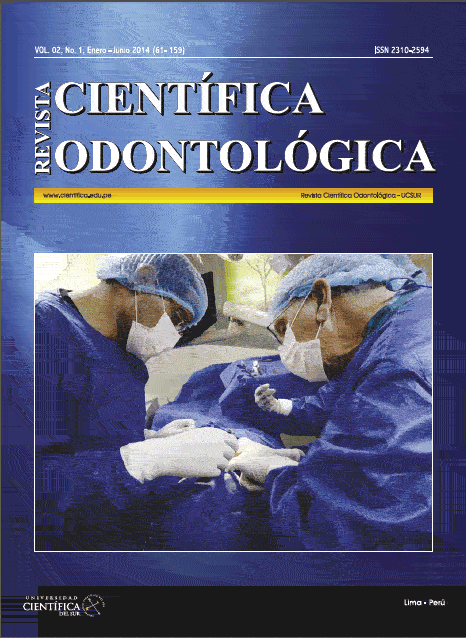Prevalencia y severidad del síndrome de hipomineralización incisivo molar en niños de 6 a 13 años de edad que asistieron a la institución educativa Lee de Forest, Lima 2012
DOI:
https://doi.org/10.21142/2523-2754-0201-2014-%25pPalabras clave:
Incisivo, Diente Molar, Sensibilidad de la Dentina, NiñoResumen
OBJETIVO: Determinar la prevalencia y severidad del Sindrome de Hipomineralización Incisivo Molar (SHIM) en niños
de 6 a 13 años de edad que asistieron a la Institución Educativa Lee de Forest, Lima 2012.
MATERIALES Y MÉTODOS: Se realizó un estudio transversal que incluyó 970 niños cuyas edades oscilaban entre 6 a 13
años de edad inscritos en el colegio Lee de Forest, Lima Perú. Se ejecutó la calibración tanto intraoperador como interoperador que constó de 20 imágenes aleatorizadas de diferentes lesiones, en la cual se obtuvieron valores de Kappa=0.873 y 0.867 respectivamente. Se examinó, en forma independiente, los primeros molares e incisivos permanentes de cada unidad de estudio clasificando correctamente la presencia del SHIM. En el trabajo se hicieron asociaciones utilizando la prueba de chi cuadrado (α=0.05).
RESULTADOS: La prevalencia total del SHIM fue de 10%. Se encontró asociación significativa en el grupo etario de 6 a
9 años de edad (p<0.001). En cuanto a la severidad el grado más severo fue encontrado en el sexo femenino con el 13%
y el sexo masculino fue afectado con 7.8% (p=0.665).
CONCLUSIONES: La severidad del SHIM en niños que asisten a la Institución Educativa Lee de Forest es leve y su prevalencia, fue de 10%, siendo este valor muy cercano a los presentados en otras literaturas.
Descargas
Referencias
Weerheijm K, Duggal M, Mejáre I, Papagiannoulis L, Koch G, Martens L. Judgement criteria for molar incisor hypomineralisation (MIH) in epidemiologic studies: a summary of the European
meeting on MIH held in Athens, 2003. Eur. J. Paediatr. Dent. 2003; 4(3):110-3.
Mathu-Muju K, Wright J. Diagnosis and treatment of molar incisor hypomineralization. Compend. Contin. Educ. Dent.2006; 27(11):604-10.
Crombie F, Manton D, Kilpatrick N. Aetiology of molar-incisor hypomineralization: a critical review. Int. J. Paediatr. Dent. 2009; 19(2):73-83.
Kotsanos N, Kaklamanos E, Arapostathis K. Treatment management of first permanent molars in children with Molar-Incisor Hypomineralisation. Eur. J. Paediatr. Dent. 2005; 6(4):179-84.
Calderara P, Gerthoux P, Mocarelli P, Lukinmaa P, Tramacere P. The prevalence of Molar Incisor Hypomineralisation (MIH) in a group of Italian school children. Eur. J. Paediatr. Dent. 2005; 6(2):79-83.
Biondi A, Cortese S. Características clínicas y factores de riesgo asociados a Hipomineralización Molar Incisiva. 2012; 25:58.
Hofman A, Moll H, Veerkamp J. Deciduous Molar Hypomineralization and Molar Incisor Hypomineralization. 2003; 43:124-7.
Ivanovic M, Zivojinovic V, Markovic D. Treatment Options for Hipomineralized First Permanent Molars and Incisors. Stom. Glas. S. 2006; 53:174-80.
Preusser S, Ferring V, Wleklinski C. Prevalence and severity of molar incisor hypomineralization in a region of Germany. J. Public Health 2014;2:75-81 81 Dent. 2007; 67(3):148-50.
Jälevik B, Dietz W, Norén JG. Scanning electron micrograph analysis of hypomineralized enamel in permanent first molars. Int J Paediatr Dent. 2005;15(4):233-40.
Logan W, Kronfeld R. Development of the human jaws and surrounding structures from birth to the age of fifteen years. Journal of the American Dental Association. 1933; 20: 379 427.
Whatkling R, Fearne JM. Molar incisor hypomineralization: a study of aetiological factors in a group of UK children. Int J Paed Dent. 2008;
:155-62.
Suckling G. Developmental defects of enamel-historical and present-day perspectives of their pathogenesis. Adv Dent Res. 1989; 3(2): 87-94.
Da Costa –Silva M, Feltrin de Souza J. Molar incisor hypomineralization: prevalence, severity and clinical consequences in Brazilian children. International Journal of Paediatric Dentistry.
; 20:426–34.
Willmott N, Bryan R, Duggal M. Molar-incisor-hypomineralisation: a literature review. Eur. Arch. Paediatr. Dent. 2008; 9(4):172-9.
Parikh M, Ganesh V. Prevalence and characteristics of Molar Incisor Hypomineralisation (MIH) in the child population residing in Gandhinagar, Gujarat, India. European Archives of Paediatric Dentistry. 2012; 13: 39-45.
Ferreira L, Paiva E, Ríos H, Boj J, Espasa E, Planells P. Hipomineralización incisivo – molar: su importancia en odontopediatría. J. Paediatr. Dent. 2005; 13: 54-9.
Jälevik B, Norén JG, Klingberg G, Barregard L. Etiologic factors influencing the prevalence of demarcated opacities in permanent first molars in a group of Swedish children. Eur J Oral Sci. 2001; 109(4): 230-4.
Jälevik B, Norén JG. Enamel hypomineralization of permanent first molars: a morphological study and survey of possible aetiological factors. Int J Paed Dent. 2000;10:278-289.
Tobias G, Fagrell P, Stina O, Jorgen G, Noren B. Bacterial invasion of dentinal tubules beneath apparently intact but hypomineralized enamel in molar teeth with molar incisor hypomineralization.
International Journal of Paediatric Dentistry. 2008; 18: 333–40.
Farah R, Drummond B, Swain M, Williams S. Linking the clinical presentation of molar-incisor hypomineralisation to its mineral density.
International Journal of Paediatric Dentistry. 2010; 20: 353–360.
Lygidakis N. Treatment modalities in children with teeth affected by molar-incisor enamel hypomineralisation (MIH): A systematic review
European Archives of Paediatric Dentistry. Dept of Paediatric Dentistry, Community Dental Centre for Children, Athens, Greece. 2010.
Tobias G, Wolframd, Jalevik B, Jorgen G. Chemical, mechanical and morphological properties of hypomineralized enamel of permanent
first molars. Acta Odontologica Scandinavica. 2010; 68: 215–22.
Lygidakis NA. Treatment modalities in children with teeth affected by molar-incisor enamel hypomineralisation (MIH): A systematic
review. Dept of Paediatric Dentistry Community Dental Centre for Children, Athens, Greece. 2010; 40- 50.
Jälevik B, Klingberg G. Dental treatment, dental fear and behaviour management problems in children with severe enamel hypomineralization of their permanent first molars. Int. J. Paediatr.
Dent. 2002; 12(1):24-32.
Brogardh-Roth S, Matsson L, Klingberg G. Molar-incisor hypomineralization and oral hygiene in 10- to-12-yr-old Swedish children born preterm. Eur J Oral Sci. 2011; 119: 33–39.
Koch G, Hallonsten AL, Ludvigsson N, Hansson BO, Holst A, Ullbro C. Epidemiologic study of idiopathic enamel hypomineralization in permanent teeth of Swedish children. Comnutry Dentistry
Oral Epidemiology. 1987; 15:269-85.
Farmakis E, Puntis JW, Toumba KJ. Enamel defects in children with coeliac disease. Eur J Paediatr Dent. 2005; 6:129-32.
Descargas
Publicado
Número
Sección
Licencia

Este obra está bajo una licencia de Creative Commons Reconocimiento 4.0 Internacional.












